Colonizing the Cosmos: Astor’s Electrical Future
30th March 2023
publicdomainreview.org /essay/colonizing-the-cosmos
Iwan Rhys Morus
During America’s Gilded Age, the future seemed to pulse with electrical possibility. Iwan Rhys Morus follows the interplanetary safari that is John Jacob Astor’s A Journey in Other Worlds, a high-voltage scientific romance in which visions of imperialism haunt a supposedly “perfect” future.
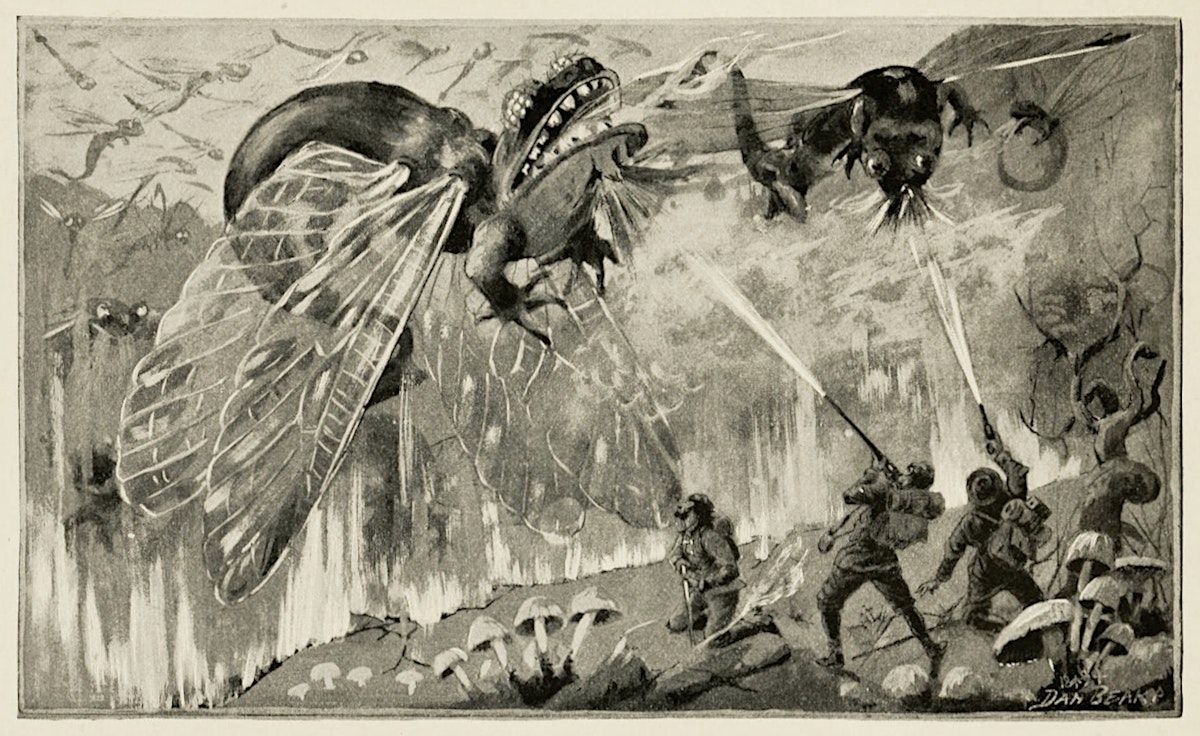
“The Combat of the Dragons”, by Daniel Carter Beard, for John Jacob Astor’s A Journey in Other Worlds (1894) — Source.
If we time travelled back to America’s Gilded Age, the closing decades of the nineteenth century, what would the future look like? The economy was booming as cities expanded and industrialization gathered pace. Railways spread across the country, fuelling westward expansion with the opening of the First Transcontinental Railway in 1869. European investors flooded this growing market as they jostled to cash in on American prosperity, and American speculators made their own fortunes, too. Day by day, the United States seemed to be accelerating into the future promised by industry. Nikola Tesla, reminiscing in later years about his 1884 arrival in New York, remembered thinking that America was “more than one hundred years AHEAD of Europe and nothing has happened to this day to change my opinion.”1
This new tomorrow was to arise through the power of innovation. In 1876, Americans celebrated a century of independence with the Centennial Exhibition in Philadelphia. The huge Corliss steam engine that dominated the main exhibition building was forty-five feet tall and, through a series of shafts more than a mile in length, powered almost every other machine present. At this same event, Alexander Graham Bell’s telephone was exhibited for the first time. And American ingenuity showed no signs of abating. Almost twenty years later, viewing Chicago’s Columbian Exposition in 1893, commentators believed they were seeing the stuff of which the future would be made — it was “a shining vision, serenely awaiting the admiration of the world”.2 What did the privileged elite of the Gilded Age, those who often funded and stood to profit most from this vision, make of all this? How would they think about their own place in the future that technological ambition and innovation seemed to offer?
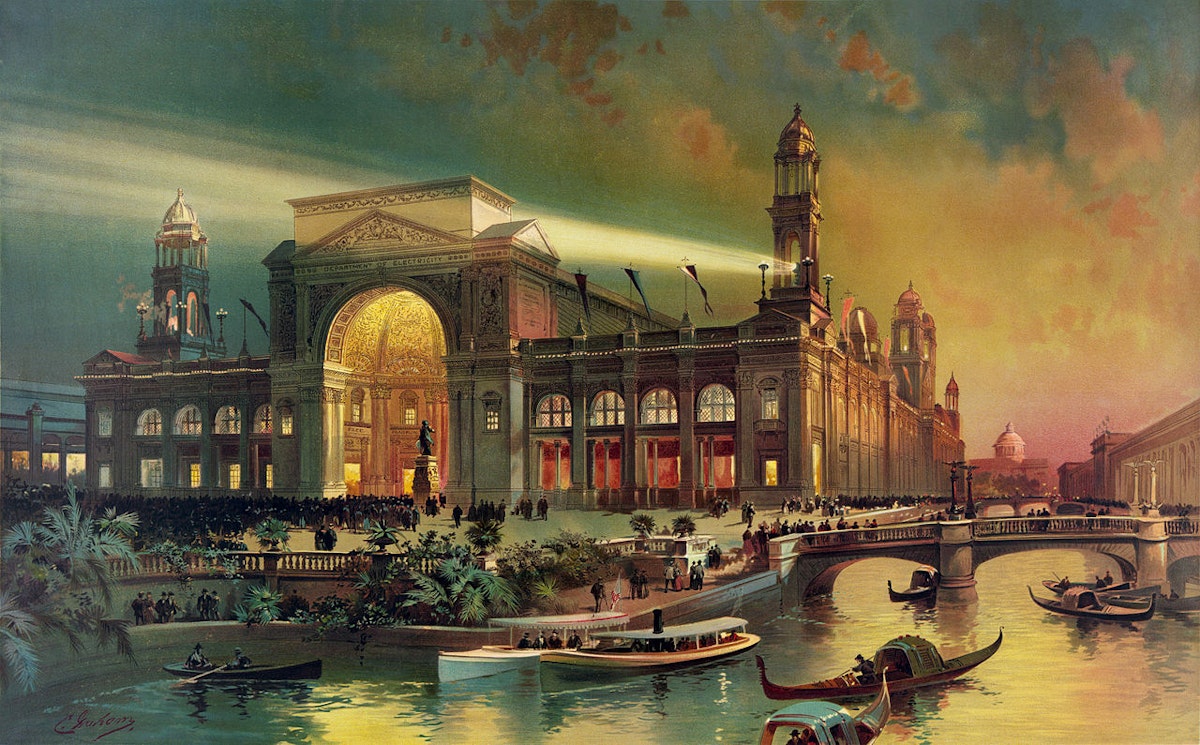
Lithograph of the “Department of Electricity”, which was powered at the 1893 World’s Columbian Exposition in Chicago using Westinghouse and Tesla’s alternating current technology — Source.
Luckily, one of them told us exactly how he imagined the century to come. In 1894, New York publishers D. Appleton and Company released A Journey in Other Worlds: A Romance of the Future, written by John Jacob Astor IV, one of America’s wealthiest men. The Astor clan had originally made their fortune in the fur trade, and had added to their millions through investment in land and property. In 1897, John Jacob would build the Astoria Hotel in New York, next door to the Waldorf, owned by his cousin William. The hotel was both a symbol of the Astor family’s wealth and a honeypot for New York’s fashionables (Tesla himself lived there until he was turfed out for failing to pay his bills). It’s Astor’s authorship that makes the book such a fascinating insight into the Gilded Age’s fantasies about its prosperous tomorrows.
A Journey in Other Worlds is an example of what was once called “scientific romance”. The thriving genre was not only published in book form, but also in popular magazines aimed at a middle-class readership. Publications such as Cassell’s Magazine, Pearson’s Magazine, or the Strand (where Arthur Conan Doyle’s Sherlock Holmes stories first appeared) allowed readers to discover scientific romances about strange new inventions, machines that could think, and travels in space. Some of Astor’s readers might, for example, have been familiar with Edward Bulwer-Lytton’s The Coming Race, written a couple of decades earlier and featuring a superhuman race of subterranean, electricity-harnessing beings. They would have read Jules Verne’s fantastic tales of adventurers journeying to the centre of the earth, or descending two thousand leagues under the sea. They might have read Edward Page Mitchell’s short story, “The Ablest Man in the World”, in the New York Sun, about a man with an artificial brain. And in the same year as Astor’s book was published, readers could have encountered Gustavus W. Pope’s Journey to Mars the Wonderful World.
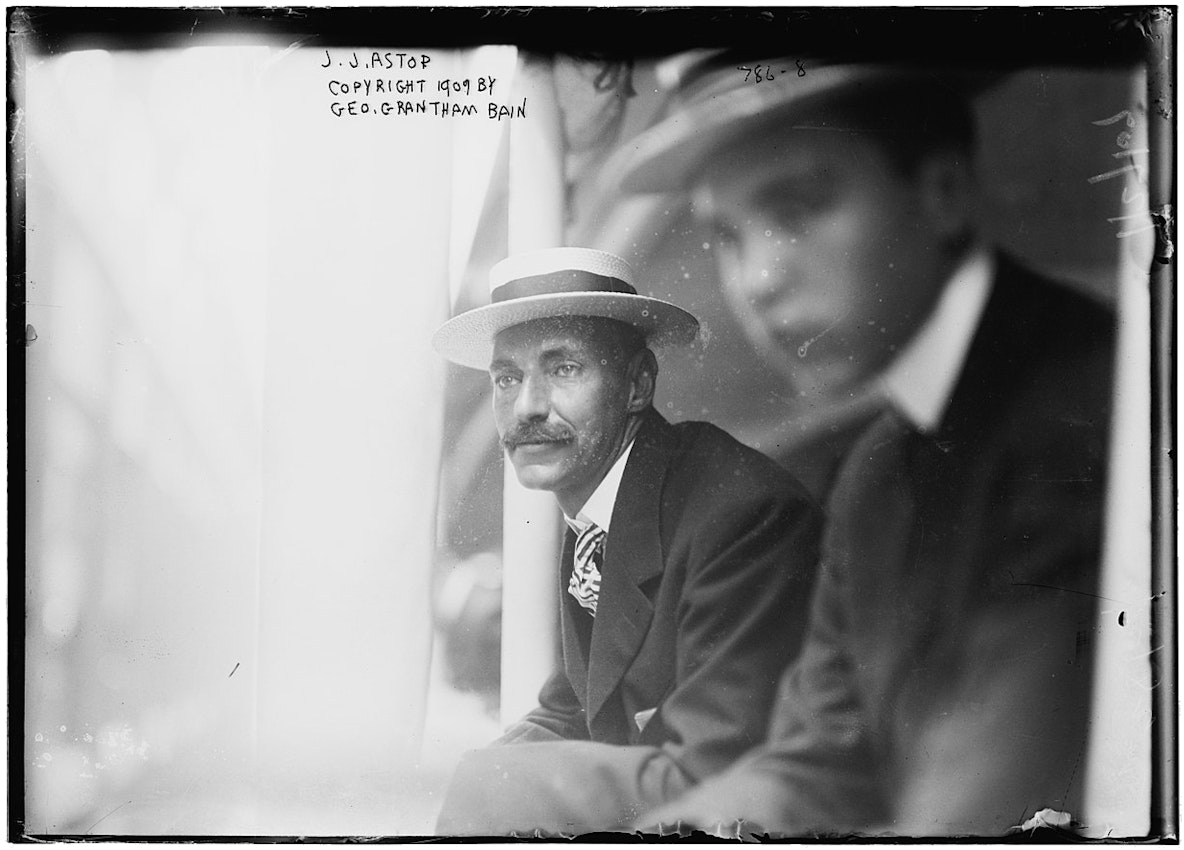
1909 photograph of John Jacob Astor leaning from a train window — Source.
That is to say, Astor’s tale would have been familiar territory for his readers, though presumably their knowledge that its author was one of the world’s richest men gave it an added edge of interest. Written at the end of a century, the story was set in the year 2000: the beginning of a new millennium. It describes a world transformed by technology, awash with free energy. The novel’s protagonists are already on their way to Jupiter in its opening chapter, relaxing in the aftermath of the triumphant campaign to straighten the Earth’s axis, doing away with the inconvenience of seasons. Readers are treated to a potted history of the past century, including how the world’s politics had been transformed, before following their heroes on a jaunt through space.
Astor’s future ran on electricity. There was nothing novel about this. His readers would have found any other choice peculiar, to say the least, for everyone knew that the future would be electrical. As early as the 1830s, pundits were enthusiastically predicting the day when “half a barrel of blue vitriol, and a hogshead or two of water” (the constituents of an electric battery) would be enough to fuel a ship crossing the Atlantic.3 By the time Astor was writing in 1894, electric power cables were already festooning the streets of many American and European cities, and a scheme to generate electricity from the Niagara falls was under way, with Astor as one of the directors. George Forbes, the project’s consultant engineer, boasted that visitors would “see a whole new world created”.4 And Nikola Tesla was busily trying to persuade investors — including Astor himself — to back his grandiose plans to distribute electrical energy without wires across the globe. Electricity was the fuel of choice for scientific romancers.
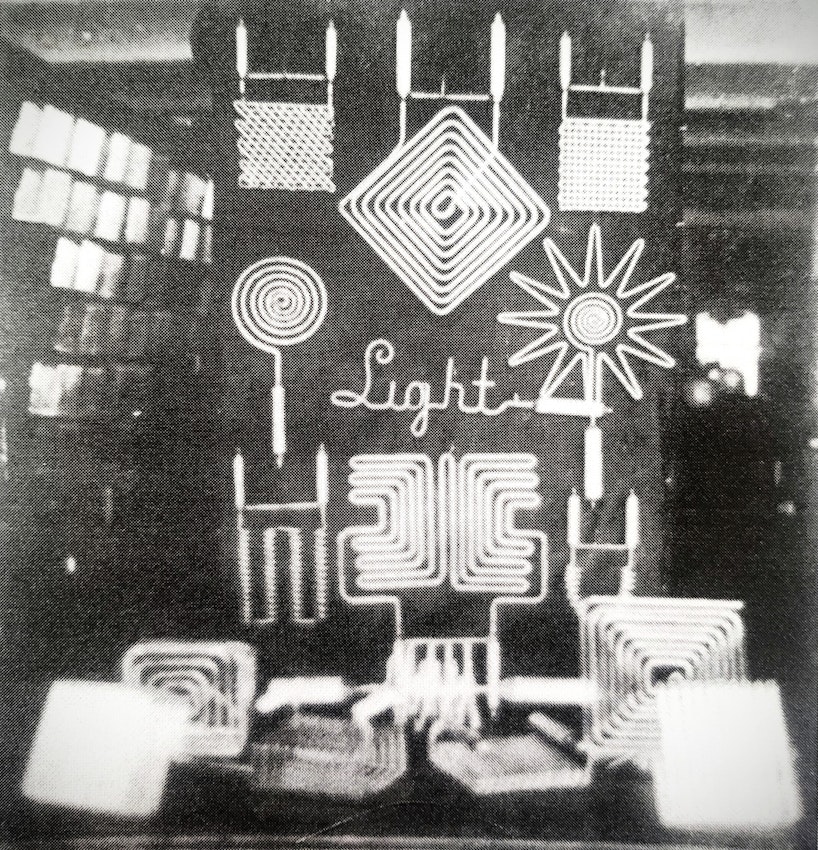
A display by Nikola Tesla for the 1893 World’s Columbian Exposition in Chicago, featuring wireless lighting tubes — Source.
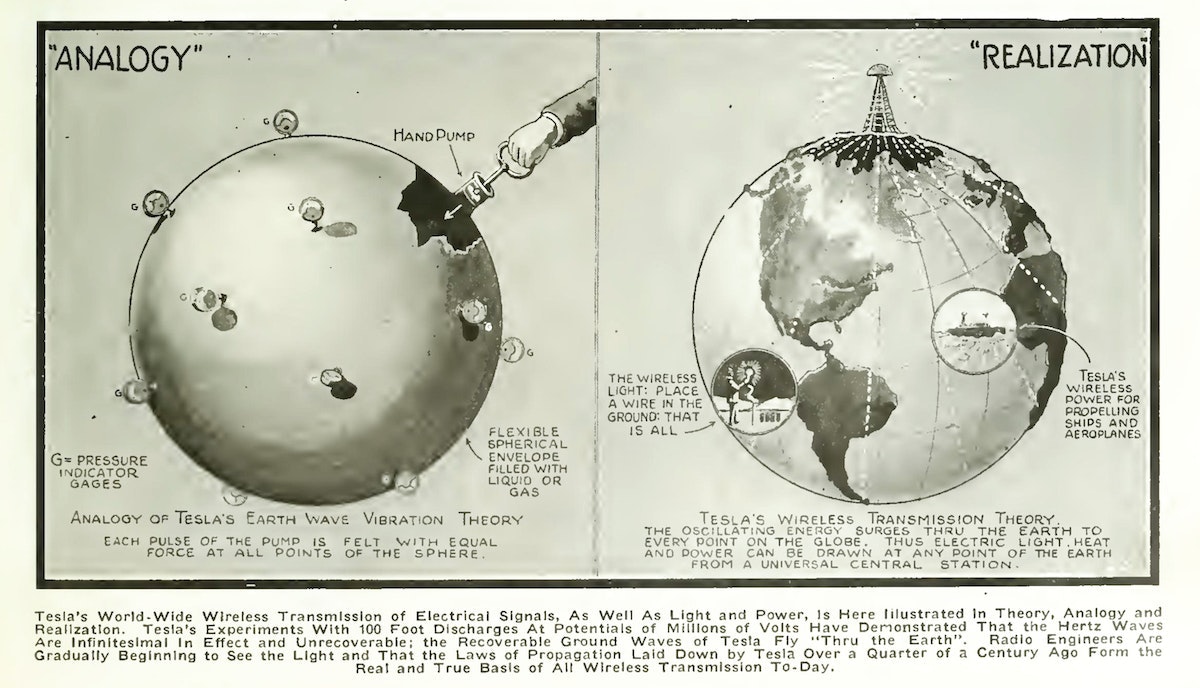
A diagram illustrating Tesla’s plan for the worldwide transmission of electrical signals, from his 1919 article “Famous Scientific Illusions” for Electrical Experimenter — Source.
What’s particularly remarkable about Astor’s vision is the sheer detail. It was all very carefully imagined. This is a future in which “[e]lectricity in its varied forms does all work, having superseded animal and manual labour in everything, and man has only to direct.”5 Everywhere, electricity is generated by the power of wind and water; the “electrical energy of every thunderstorm is also captured and condensed in our capacious storage batteries”; the “windmill and dynamo thus utilize bleak mountain-tops that, till their discovery, seemed to be but indifferent successes in Dame Nature’s domain.”6 Renewable electricity is used to “run our electric ships and water-spiders, railways, and stationary and portable motors, for heating the cables laid along the bottom of our canals to prevent their freezing in winter, and for almost every conceivable purpose.”7 Everyone has a windmill on their roof.
Astor offered his readers a blueprint for the coming century that laid out how they would get from their present to the electrical future. “This period — A. D. 2000”, one of his characters says, “is by far the most wonderful the world has as yet seen.”8 The wonder was the result of science and technology, of course, and all that plentiful electrical energy. It’s no surprise that Tesla thought (wrongly, as it turned out) that Astor would be an easy touch for cash to fund his dreams of wireless power. The spread of republican ideals in the aftermath of the French Revolution more than two centuries earlier, and the great advances in science that accompanied it, meant that “education has become universal, for women as well as for men, and this is more than ever a mechanical age.”9 Astor’s future was the end-point of the inexorable march of progress. Science had generated “this perfection of civilization”.10
It was only a perfect civilization for some, however. In the same year that Astor published A Journey in Other Worlds, women suffragists presented an unsuccessful petition with almost 600,000 signatures at the New York State Constitutional Convention, while the United States Supreme Court passed the Civil Rights Repeal Act, overturning congressional protections for the voting rights of Black Americans. The inequalities of Astor’s present remain largely unaddressed in his vision of the future, and in some respects are hideously amplified. While women benefit from universal education, there is no mention of suffrage, and the physicians of the future are solely “serious and thoughtful men”, whose research finds “the physique, especially of women, . . . wonderfully improved”.11 Meanwhile, Astor’s twentieth century is primarily shaped by white Anglophones conquering every region of the planet. A Journey in Other Worlds cannot imagine a future that is not built from colonial violence.
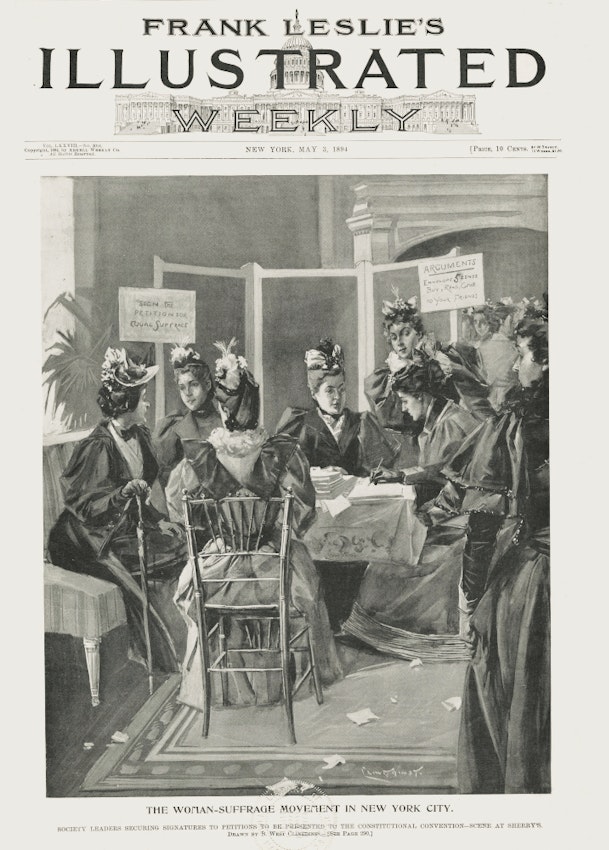
Cover of the May 3, 1894 issue of Frank Leslie’s Illustrated Weekly, depicting the petition efforts of “The Woman-Suffrage Movement in New York City” for the Constitutional Convention — Source.
Astor’s novel describes how, in the aftermath of the Franco-Prussian war, continental Europe descended into a perpetual state of warlike antagonism between the great powers of France, Germany, and Russia, whilst England “preserved a wise and profitable neutrality”.12 One result was a technological arms race as the competing nations developed larger and deadlier armaments. Metallurgy flourished in the search for advanced weaponry; chemists developed better explosives; and the invention of flying machines made them all too dangerous to use. “These tremendous sacrifices for armaments, both on land and water, had far reaching results, and, as we see it now, were clouds with silver linings”, says Astor’s future historian.13 The great war never came, and the continental rivals stagnated in perpetual stalemate: “the rival nations had their pains for nothing, or, rather, for others than themselves.”14
The other result was mass-migration, as weary Europeans left the continent and its antagonisms for better lives elsewhere. At the same time, the “jealousy of the Continental powers for one another” put a stop to these nations’ dreams of empire, leaving the world free for exploitation by Britain and the United States.15 English was on its way to becoming a universal language, through eradication rather than acquisition. “Spanish and Portuguese elements in Mexico and Central and South America show a constant tendency to die out”, reports Dr. Cortlandt with sinister ambiguity.16 And the perished residents of these regions are gradually replaced by the supposedly “more progressive Anglo-Saxons”, making “the study of ethnology in the future. . . very simple”.17 By the end of the twentieth century, Canada had joined a United States that now spread over both North and South America. Britain in the meantime had free rein to assimilate much of Africa and Asia into the British Empire (Astor was writing during the Scramble for Africa). Due to improvements in condenser technologies, allowing water to be made from air, “mile after mile of Africa has been won for the uses of civilization”, and “the erstwhile ‘Dark Continent’ has a larger white population now than North America had a hundred years ago”.18
That was the “perfect” world from which Astor’s protagonists set out on their jaunt to the planets — a future that reflected the Gilded Age elite’s fantasies of empire and colonial settlement. Their planetary encounters would be similarly revealing. As far as his characters were concerned, their own world had reached perfection and it was time to embark for the stars: the next stage in humanity’s manifest destiny. The spaceship built by Colonel Bearwarden — president of the Terrestrial Axis Straightening Company — and his companions is called the Callisto (the name of Jupiter’s second largest moon). Constructed entirely from beryllium, an electrically-conductive element, the ship is powered by apergy: a term that had been invented by the author of scientific romances Percy Greg, in his 1880 story Across the Zodiac, to describe a kind of anti-gravitational force. Astor is vague about how exactly his version of apergy works, but the implication is that it operated through some kind of modification of electricity.
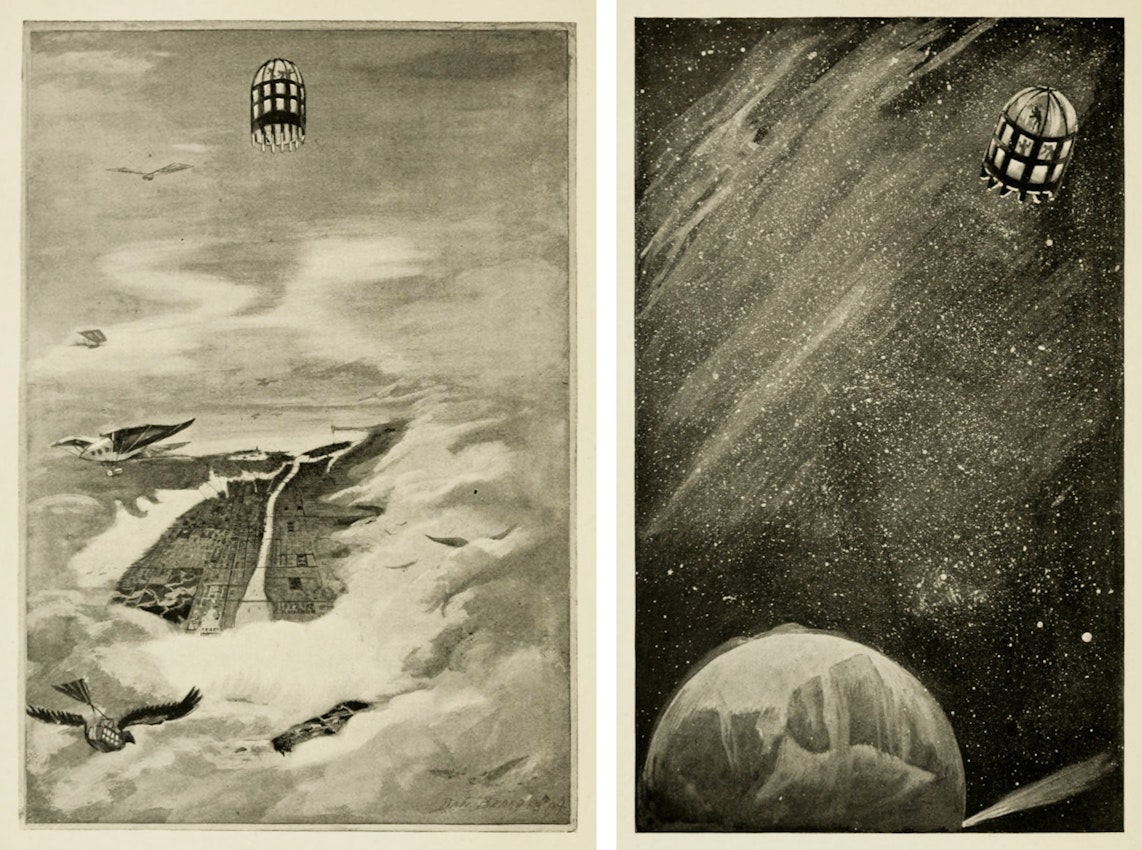
“The Callisto was going straight up” and “The signals from the Arctic circle”, by Daniel Carter Beard, for John Jacob Astor’s A Journey in Other Worlds (1894) — Source: left, right.
Bearwarden chooses Jupiter and Saturn as the expedition’s ultimate destination, planets that seem to offer the best prospects for human habitation and colonization. “I am convinced”, he says, “that we shall find Jupiter habitable for intelligent beings who have been developed on a more advanced sphere than itself, though I do not believe it has progressed far enough in its evolution to produce them.”19 The belief that life existed on other planets was widespread throughout the nineteenth century. And the notion that the various planets of the solar system might be at different stages of evolution was also a common one in scientific romances (H. G. Wells would use it in his War of the Worlds just a few years later, for example). As far as the adventurers on the Callisto are concerned, the planet’s primitiveness made it an ideal space for human conquest — almost as if it had been made for them.
In due course, they are off, with great pomp and circumstance — flags waving and a twenty-one-gun salute ringing in their ears. The space through which Astor propelled them was increasingly familiar territory by the 1890s. They whiz past the Moon: “[t]here was something awe-inspiring in the vast antiquity of that furrowed lunar surface, by far the oldest thing that mortal eye can see”.20 That lunar surface had been photographed as early as the 1840s and was exhaustively mapped by the 1890s. They pass by Mars and its two satellites. As with the Moon, Astor’s readers would probably have been quite familiar with the Martian surface. Given Giovanni Schiaparelli’s and Percival Lowell’s observations of canals on Mars, it is perhaps surprising that his travellers do not spot any. They do, however, see a comet, and even take a ride inside its tail. And they pass through the asteroid belt, finding an atmosphere: “oceans and continents, with mountains, forests, rivers, and green fields”.21
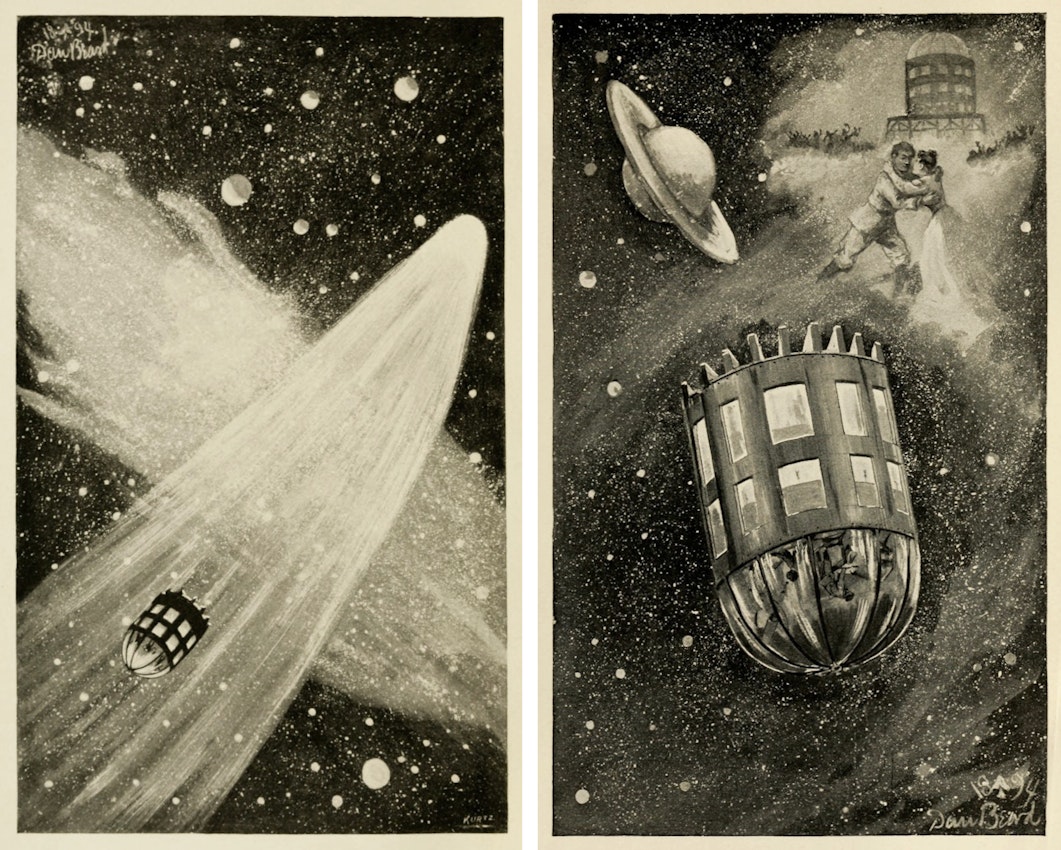
“The Callisto and the comet” and “The return”, by Daniel Carter Beard, for John Jacob Astor’s A Journey in Other Worlds (1894) — Source: left, right.
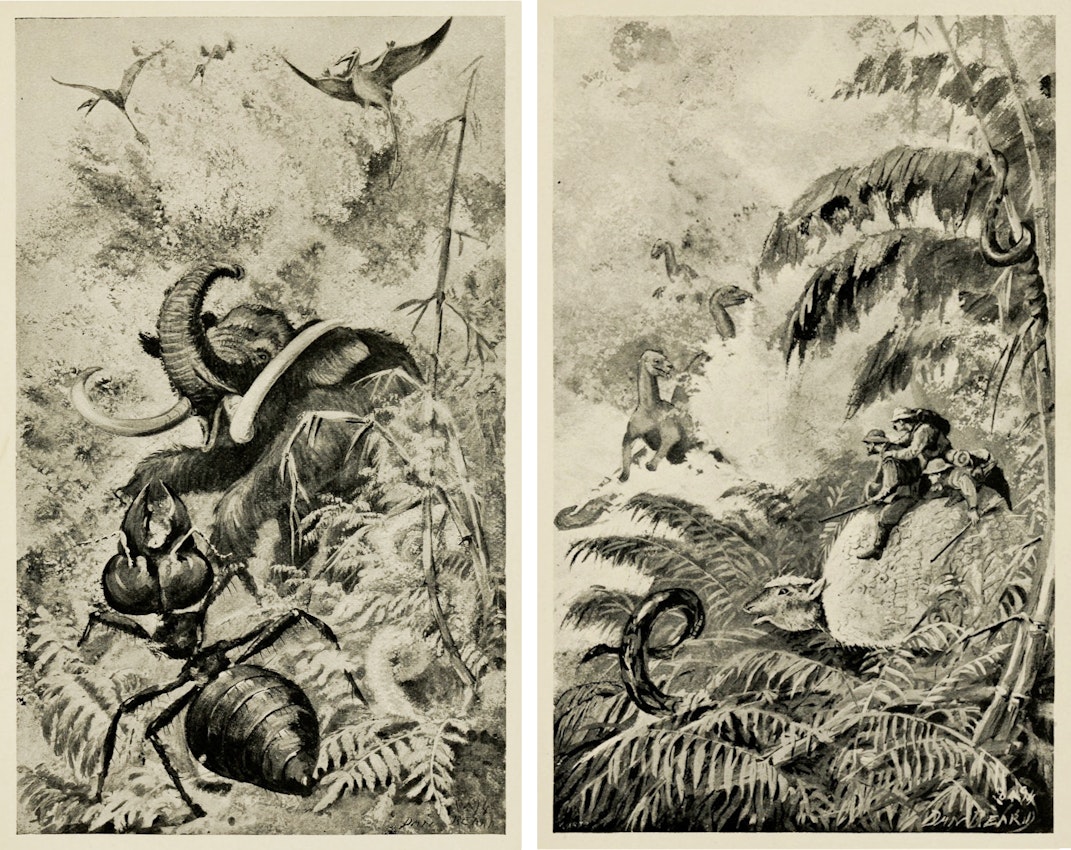
“A battle royale on Jupiter” and “The ride on the giant tortoise”, by Daniel Carter Beard, for John Jacob Astor’s A Journey in Other Worlds (1894) — Source: left, right.
Flying at last over the surface of Jupiter, the crew of the Callisto marvel at the “towering and massive mountains” and “smoking volcanoes”.22 Heading west, they see “gently rolling plains, and table-lands that would have satisfied a poet or set an agriculturalist’s heart at rest”.23 Their response to these sights is revealing of what Astor thought the planets were really for: “‘How I should like to mine those hills for copper, or drain the swamps to the south!’ exclaimed Col. Bearwarden.”24 Jupiter was a future Africa or American west — a space deemed ripe for exploitation. “Not even did Columbus, standing at the prow of the Santa Maria, the New World before him, feel the exultation and delight of these latter-day explorers of the twenty-first century.”25
Saturn, on the other hand, is an abode of the dead. Spiritualism and theosophy were all the rage in fashionable American society during the 1890s, and Astor was not the only one to play with the idea that the planets might represent higher spiritual planes. A few years later, Louis Pope Gratacap would devote an entire novel to the proposition that Mars was inhabited by the dead, who could be communicated with using wireless telegraphy. In this case, the presence of spirits does not prevent the Callisto’s crew from continuing their interplanetary safari. When they eventually return to Earth, they might be spiritually elevated, but they are also well aware of new worlds still to conquer: “Remember, we have been to neither Uranus, nor Neptune, nor Cassandra, which may be as interesting as anything we have seen”, Bearwarden says, taking leave of his fellow-travellers, “should you want to take another trip, count me as your humble servant.”26
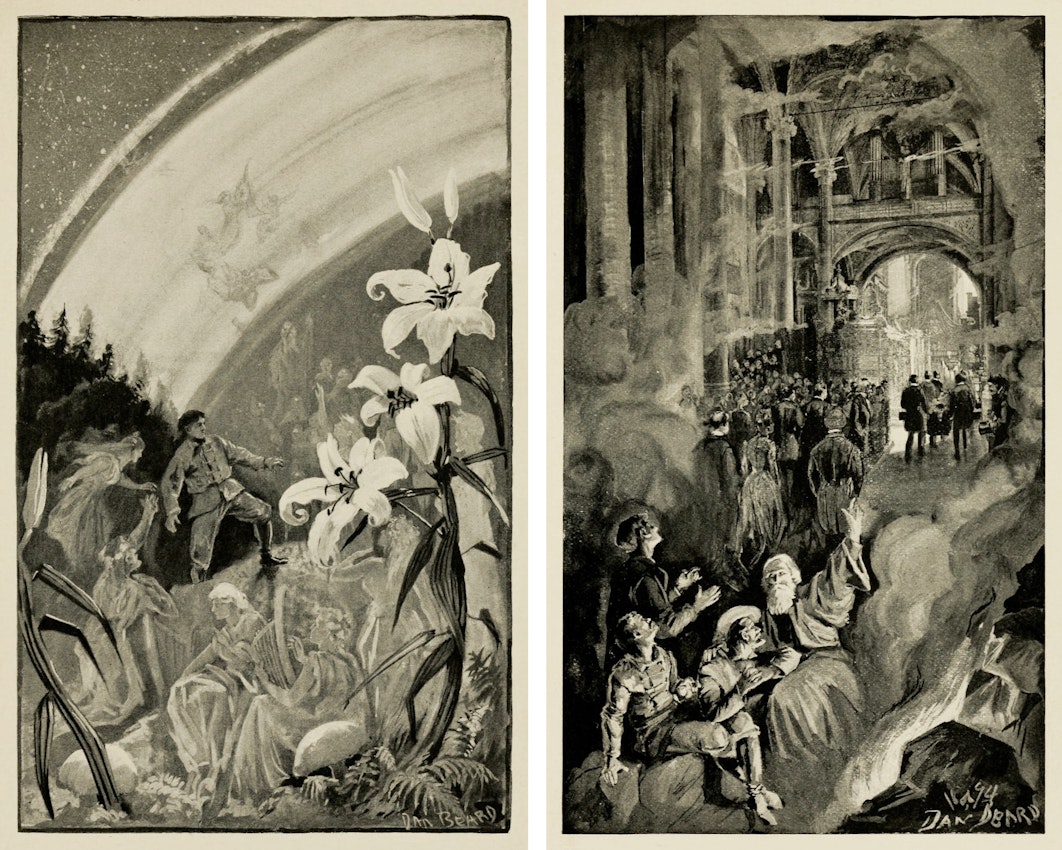
“Ayrault’s vision” and “They look into the future”, by Daniel Carter Beard, for John Jacob Astor’s A Journey in Other Worlds (1894) — Source: left, right.
A Journey in Other Worlds is a fascinating and revealing novel, which tells us a good deal about the way in which Astor and his readers viewed their future. This is important, because even though the future did not entirely match their fantasies, those fantasies were still key to making the modern world. It’s a future saturated with technology, and electrical technology in particular. Electricity is what makes Astor’s future world go round — literally, in fact, since it was electricity that Astor imagined pumping water back and forth between the poles to fulfil the peculiar ambition of righting the Earth’s axis and eliminating the seasons. This was the future projected by inventor-entrepreneurs like Tesla, too, and embodied in World’s Fairs. Astor’s story offers insight into just how seductive this vision of the future was to the Gilded Age’s privileged elites. It’s striking that the novel’s protagonists are men clearly modelled on Astor himself. They are powerful and wealthy, the heads of corporations and committed to technological futurism.
More striking still, though, is the theme of empire. Bearwarden and his crew were heading to Jupiter for a specific kind of adventure. Jupiter’s exotic “Jurassic or Mesozoic” creatures, or Saturn’s “dragons” were just big game, as far as they were concerned. This was space travel as safari. But like Victorian big game hunters and explorers in Africa — both real and fictional — even as they bagged their trophies, they were casting covetous eyes over the landscape, too. Jupiter and Saturn (and presumably the other planets in due course) are places to be colonized. They were places where farms might be established, mines sunk, and resources extracted. They are different in scale, but not in kind, from how Astor’s novel envisions continents such as South America and Africa in the twentieth century: blank canvases, shorn of subjects, on which to paint dreams of supremacy. As things turned out, of course, Astor never came anywhere near the future he imagined. He died on April 15, 1912, the richest victim on the Titanic. But it’s clear that the future he imagined and wrote about was a future tailored for men like him.
Iwan Rhys Morus is professor of history at Aberystwyth University. He graduated in Natural Science from Cambridge University in 1985 before going on to complete an MPhil (1986) and PhD (1989) in History and Philosophy of Science there. He has published widely on the history of science, including Nikola Tesla and the Electrical Future (Icon, 2019) and, most recently How The Victorians Took Us To The Moon (UK, Icon; US, Pegasus Books, forthcoming 2022). He lives in Aberystwyth, Wales.



Recent Comments